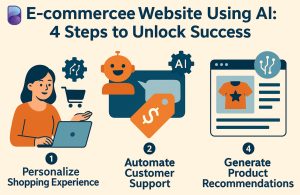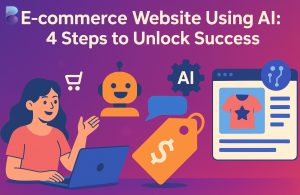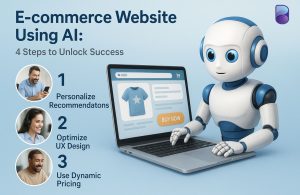Do you intend to develop your internet business store? Let it be said that it is time to introduce your e-commerce website using AI! This tech lets you design your online shop as you wish. It responds to customer behavior, giving relevant suggestions and quickly meeting their needs. AI saves you time and energy. It tracks stocks, processes orders, and answers customer queries.
Strategies for AI integration in e-commerce
When applied to e-commerce, AI can improve customer experience through personalization. AI-tuned experiences make shoppers feel like valued customers. The best part? With today’s tools, you can build an e-commerce website using AI in minutes.
AI helps to unveil hidden aspects of data for improved decision-making. For example, a customer with a product in mind will have their behavior analyzed.
This will recommend similar products they may like. It can also order products when inventory is low to replenish the existing stock.
Real-life active chatbots combine talking to a customer with asking and answering questions. This reduces the need for a team of experts on call all day.
AI-based Analysis of E-Commerce Websites
An e-commerce website using AI also reduces a physical store, as everything is done online using a button. AI can make your online shop smarter.
AI in e-commerce enhances your store by providing a technological advantage by analyzing your customers’ buying habits.
For example, if you own an online apparel store, AI can help you find similar products the customer has bought. One will feel like having an online shopping assistant with a clear idea about the buyer’s choice of dress and texture.
Step 1: Planning Your AI – Powered E-Commerce Website
The first process in developing an e-commerce website using AI is planning where you want to sell something. What do you want on your site: product recommendations, customized shopping, and so on?
An e-commerce website design is essential. Customers will buy your products if they find your site high-quality and easy to use.
When building your e-commerce website, the design must be simple, the colors pleasant, and the typeface significant. A wide selection helps customers shop efficiently and find what they need, boosting repeat business.
Your website should also be working properly, with all its features synchronizing correctly, to offer a smooth buying experience.
If you plan to sell tangible products, downloadable content, or services, select a provider with features that allow safe and effective transactions.
Another crucial feature to consider when using an e-commerce website is its mobile responsiveness. Your website must be mobile-optimized or tablet-based since search engines favor mobile-friendly websites.
SEO plays a vital role in the development of e-commerce website designs. Include relevant keywords in your site’s content, title tags and descriptions, URLs, and headings.
That way, your site gets a better rank on search engine results and, hence, the chance to reach more possible clients.
Another important factor is security. Minimize the risks from hackers by using secure forms of payment, encrypting information, and updating your software frequently.
Step 2: Building Your E-Commerce Website
After you have developed your site plan, it is time to proceed to physical construction. You could use platforms like Wix or Shopify to build your eCommerce store or hire a custom website developer.
If you use a drop-and-display builder such as Shopify or WooCommerce, search for a suitable set theme, edit it to match your brand, and upload your products.
These platforms have features that enable one to compute orders and manage stock, among other things.
You can also ask a web developer for an individual website to draw a website that is uniquely created for your company’s use. This site can integrate AI into consumer shopping, making the process easier and more efficient.
Using AI, product promotions and customer assistance prompts can be managed; chatbots and computerized marketing emails make customers happy.
Monotonous activities such as updates can be eliminated. This is time-saving and helps avoid incorrect database entries. You can also analyze clients’ information for better marketing strategies.
Step 3: Selecting the Appropriate E-Commerce System
This is why an e-commerce website must use AI to select the right platform. Good customer service and a good reputation are also important. Another element that could be discussed is scalability.
Choose a platform: expand, Offer more products, or Increase the number of markets associated with it to effectively handle a larger number of visitors.
It should also have cheap and easy-to-understand packages explaining the features that will benefit your business.
It should be convenient to work with that device even if some part of the experience requires the user to get used to it. It should at least have templates and some marketing and analytics tools.
Step 4: Improving your website for e-commerce
By now, you must think that developing your website is the end of the process. Consequently, you must fine-tune it repeatedly if you want to stay competitive.
Employ AI analytics to assess your website and clients’ activities and results. After that, fine-tune it according to the outcome achieved.
Therefore, every e-commerce website must be optimized to keep abreast of the latest developments in the growing field of e-commerce. Your closest company would be Business Intelligence or data analytics.
So, it’s possible to stress that. Better customer understanding through surveys or by analyzing marketing campaigns can boost sales. AI analytics tools can find future trends. They help you prepare for competition and plan inventory and marketing.
Conclusion
Constructing an e-commerce site using AI can be daunting, but it is possible. Here are the steps to create a bright, efficient online store that attracts customers and sales.
Constant improvement will help your business succeed in today’s e-commerce market. For your business expansion, it is time to have an AI-enabled e-commerce website builder.
FAQ’s About E-commerce Website Using AI: 4 Steps to Unlock Success
What is the future of Artificial Intelligence in building e-commerce websites?
AI degrees in e-commerce help with recommendations, customer relations, inventory, and data analysis. It will help in firm growth and boost sales and customer satisfaction.
Can we do an AI-powered e-commerce website design using this method?
You can use e-commerce website builders like Shopify or WooCommerce, which have feasible UI/UX and built-in AI functionalities, such as recommendations or chatbots. These tools let anyone design a website. No programming skills are needed.
Where is the application of the tools useful for an e-commerce website?
Every business wants to know customers' behaviors and visit frequency. You can monitor your website's performance and use AI Analytics to improve it.
What factors should we consider when choosing an e-commerce platform for AI integration?
A platform can help a business grow and succeed by using AI, providing quality service, and being user-friendly. It can provide all it needs to operate.



